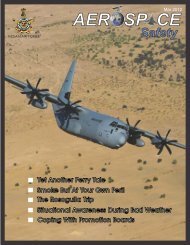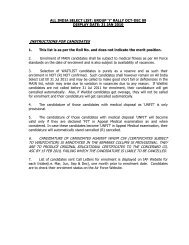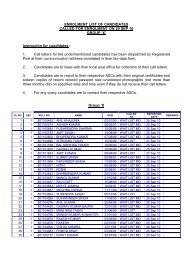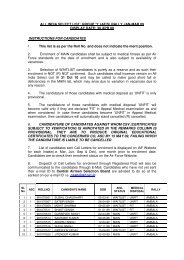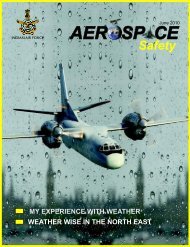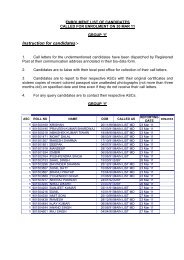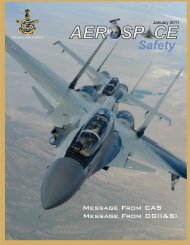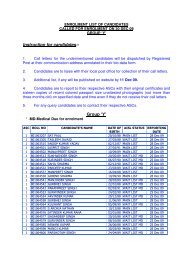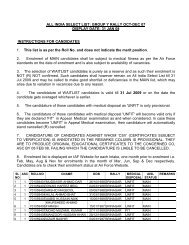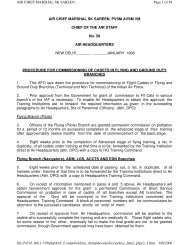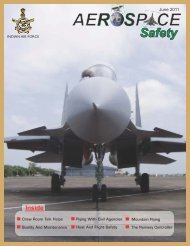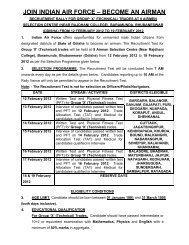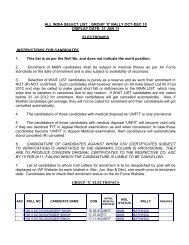final feb cover - Indian Airforce
final feb cover - Indian Airforce
final feb cover - Indian Airforce
Create successful ePaper yourself
Turn your PDF publications into a flip-book with our unique Google optimized e-Paper software.
Feb 2012<br />
AEROSP CE<br />
Safety<br />
inside<br />
2<br />
‘Chalta-Hai’ - The Story<br />
of Leaking Hose<br />
8<br />
Focus with Energy<br />
& Commitment...<br />
18<br />
FFI & FOD Parade<br />
Common Theme
Feb 2012<br />
AEROSP CE<br />
Vol.193<br />
Safety<br />
Director General (Inspection & Safety)<br />
Air Mshl AP Garud VM<br />
Principal Director Aerospace Safety<br />
Air Cmde R Marwaha VSM<br />
Chief Editor<br />
Gp Capt DK Singh<br />
Editors<br />
Wg Cdr GS Bishen<br />
Cdr Nikhil Saolapurkar<br />
Sqn Ldr Shashank Sharma<br />
Editorial Assistants<br />
Mr Rakesh Kumar Singh<br />
Mrs S Sangeetha<br />
Cpl RS Thokchom<br />
Graphic Design<br />
JWO G Ramesh<br />
Sgt Chetan Chauhan<br />
Sgt DK Chatterjee<br />
Mr Rajib Paul<br />
Articles/Suggestions may be sent to:<br />
Editor, Aerospace Safety<br />
Institute of Flight Safety<br />
Air Force Palam, New Delhi-110 010<br />
Tele : 011-25672871, 23247789(AFNET)<br />
Fax: 011-25675059<br />
e-mail: editorfsmiaf@yahoo.com<br />
AFNET: flightsafety@dg.iaf.in<br />
Every article must be accompanied<br />
by a brief bio-data and passport size<br />
photograph of the author.<br />
'Aerospace Safety' magazine can be<br />
viewed on the intranet at<br />
http://www.iaf.in/dg/dgissite/fltmagazine.htm<br />
and on the internet at<br />
http://www.indianairforce.nic.in<br />
Suggestions and inputs on Quality<br />
Control issues of the IAF could be sent<br />
to DG(I&S), IAF by e-mail at the<br />
following address: dg_is@yahoo.com<br />
Round-the-clock contact of Principal<br />
Director Aerospace Safety:<br />
Tele:<br />
011-26172738 (Off)<br />
21125130, 21125131 (AFNET)<br />
011-27018241 (Res)<br />
+91-9717095606 (Mob)<br />
e-mail: pdfs_iaf_in@indiatimes.com<br />
AFNET: pdfs@dg.iaf.in<br />
inside<br />
2 Chalta Hai-The Story of Leaking Hose<br />
Gp Capt VVN Srikanth<br />
4 First Air Crash in the History of Aviation<br />
Gp Capt CN Ghosh VM<br />
8 Focus with Energy & Commitment, Execute with Passion<br />
and Precision<br />
AVM Subramanyam<br />
12 MCC - A Bond between Operation and Maintenance<br />
Sgt Aruni Kumar<br />
16 The Over Enthusiastic Comrade<br />
Sqn Ldr MD Sharma<br />
18 FFI and FOD Parade: Common Theme<br />
Gp Capt Narinder Taneja<br />
22 Why this ‘Press-on-Itis’ Ji<br />
Wg Cdr Ashish Kapoor<br />
26 Safe Ground Runs and Safety Norms<br />
WO Kishore Kumar S<br />
28 Accident Brief<br />
32 Good Show<br />
34 Well Done<br />
36 Message<br />
2 12<br />
18<br />
The opinions expressed in the ‘Aerospace Safety’ magazine are<br />
the personal views of the authors, and do not reflect the official<br />
policies of Air HQ. Contributions are welcome, as are comments<br />
and criticism. The Editorial Board reserves the right to make any<br />
improvement/change in the manuscripts.
Editorial<br />
he article on 'First Air Crash in the History of Aviation' takes us down the memory lane and<br />
recounts the initial odds in the history of aviation. We have indeed moved a long way in the<br />
Tform of technological advancements in the field of aviation and the way we in which any<br />
mission is carried out in present day scenario.<br />
The intricacies involved in a successful mission in the present day, especially in military<br />
aviation, pose a comprehensive challenge and necessity of effective and meticulous synergy. Once<br />
this is achieved or close to it, there comes the 'Human Factors' in undertaking the set organizational<br />
goals effectively and still safely. The articles like 'Chalta Hai', 'MCC – A Bond Between Operations<br />
and Maintenance' and 'Safe Grounds Run and Safety Norms' highlight the importance of these<br />
intricacies and the need to undertake the given task meticulously.<br />
The necessity of grooming an Airwarrior with multi tasking capabilities and its inherent<br />
challenges in the form of loss of 'focus' towards undertaking a mission or achieving a target needs<br />
attention. The supervisors at all levels need to be proactive in their approach in ensuring that the<br />
present genre of Air warriors are focused in their tasks and carry no distractions to the aircraft.<br />
Happy landings!<br />
(DK (DK Singh) Singh)<br />
Group Group Captain Captain
Gp Capt VVN Srikanth<br />
2 Aerospace Safety F e b r u a r y 2 0 12<br />
INDIAN AIR FORCE
When questioned as to when had the leak started,<br />
he replied that it had been there for a long time and<br />
since there was only one refueling cart in the unit,<br />
it could not be repaired<br />
This incident happened in a RPA Sqn. The RPA<br />
refueling is done with the help of a wheel<br />
based refueling cart that is towed by the MM<br />
Jeep. It is a gravity based refueling equipment<br />
which has a long hose pipe. One day while strolling<br />
on a routine walk around the Sqn Hangar, I noticed<br />
a Heron RPA being refueled by the tradesmen on<br />
duty. The senior most technical tradesman present<br />
there was a Sgt with 18 years of service with a team<br />
of two LACs with limited experience on the RPAs. It<br />
was noticed by me that the fuel was leaking from<br />
the metal joint of the refueling hose and there<br />
was a pool of fuel on the ground. It was evident<br />
that the tradesmen were aware of the leaking hose,<br />
but continued with their refueling activity. On<br />
questioning the Sgt as to why he was continuing<br />
in-spite of fuel leakage, he replied that such<br />
leakage is normal and that there was no problem<br />
in continuing with the refueling activity. Once the<br />
refueling was completed the safaiwala would come<br />
and mop up the fuel on ground. When questioned<br />
as to when had the leak started, he replied that it<br />
had been there for a long time and since there was<br />
only one refueling cart in the unit, it could not be<br />
repaired. The refueling activity was stopped by me<br />
and it was directed that the refueling be done only<br />
if the hose was repaired even at the cost of stopping<br />
flying. The hose was repaired locally by changing<br />
the rubber seal in about an hour.<br />
It is evident that the refueling activity with<br />
the leaking hose continued due to the ‘Chalta Hal’<br />
attitude. Even the senior supervisors continued<br />
with the practice. Analysis of the event brought out<br />
following aspects:<br />
The senior Sgt had in the past probably<br />
seen refueling activity being undertaken with a<br />
leaking hose while working on other ac and felt<br />
that it was safe. Having such activities/shortcuts<br />
being adopted as he grew up in service, as a<br />
senior supervisor he permitted similar activity. It<br />
was indirectly being conveyed to those young<br />
tradesmen who would continue in service for<br />
another 15-20 years, that such wrong practices/<br />
shortcuts are acceptable.<br />
There needs to be proper supervision of<br />
all activities, and no shortcuts should be adopted<br />
which could lead to the juniors observing and<br />
learning from each one of us.<br />
In this case the Sgt cannot be blamed<br />
because he grew up in the system fraught with<br />
such examples. I am sure there is no aviator who<br />
has not come across a scenario wherein the aircraft<br />
were refueled with leaking hoses. Those from<br />
the MiG-21 fleet are aware of instances wherein<br />
the engine tradesman sits on the fuselage and<br />
refuels with fuel dripping from the sides a practice<br />
accepted as normal procedure.<br />
All of us agree that a right man for the right<br />
job is very important. But, it works only when the<br />
right man gets the right training at the right time.<br />
Correct lessons should be imparted at all times<br />
and incorrect practices nipped at the budding<br />
level for a safe and bright aerospace power.<br />
It is very true that, “What mind does not<br />
know eyes cannot see” -Therefore, be aware and<br />
be conscious of Safety. ‘It is not my job’ and ‘chalta<br />
hai’ attitude are sure precursors to an accident/<br />
incident.<br />
-Gp Capt VVN Srikanth<br />
INDIAN AIR FORCE 2 0 1 2 F e b r u a r y Aerospace Safety 3
BLAST FROM THE PAST Safety Journal Vol XXIX, 1/90<br />
Gp Capt CN Ghosh VM<br />
Orville Wright was the first of the two<br />
creators of the modern aeroplane, who<br />
also met with an air-crash in the very<br />
beginning of the history of aviation. Luckily,<br />
this disaster did not turn him away from planes,<br />
otherwise what turn the history of aviation may<br />
have taken is anybody’s guess. The courage and<br />
determination, so typical of a flyer, that Orville<br />
displayed then, is being emulated and displayed<br />
even today by thousands of flyers all over the<br />
world.<br />
It was thick of winter. On 23 December 1907<br />
the slumber of the US Army was disturbed by what<br />
is a quirk of history. The US Signal Corps decided<br />
to buy a lighter than air machine and advertisedaccordingly.<br />
The advertisement stated :-<br />
“Lighter than air machine is required. It should<br />
have the capability to carry two men on a sustained<br />
flight of sixty minutes. Its range should be atleast<br />
125 miles and an average speed of 40 miles over a<br />
course of ten miles had to be attained. The ability<br />
should be there to steer it in all directions easily.<br />
Also the plane had to be constructed in such a way<br />
that it could be taken apart for transportation by<br />
truck and easily reassembled.”<br />
The advertisement stirred a hornets’ nest.<br />
The Signal Corps become a centre of journalistic<br />
4 Aerospace Safety F e b r u a r y 2 0 12<br />
INDIAN AIR FORCE
abuses, not because it had been slow to recognise<br />
the invention, but because it had done so at all.<br />
The New York Globe wrote in an editorial :-<br />
“One might be inclined to assume from the<br />
following announcement “The US Army is asking for<br />
bids for a military airship” that the era of practical<br />
human flight had arrived or that the government<br />
had seriously taken up the problem of developing<br />
this means of travel. A very brief examination of<br />
the conditions imposed suffices, however to prove<br />
this assumption a delusion. A machine such as is<br />
prescribed on the Signal Corps specifications would<br />
record the solution of all the difficulties in the way<br />
of the heavier than air airships, and, in fact, <strong>final</strong>ly<br />
give mankind almost as complete control of the<br />
air as it now has of the land water. Nothing in any<br />
way approaching such a machine has even been<br />
constructed.”<br />
The Globe brushed aside the claims of Wright<br />
brothers as unconfirmed rumour.<br />
Even the American magazine of Aeronautics<br />
in its January 1908 edition castigated the Signals<br />
Corps for its imaginative scheme. It said “There<br />
is not a single flying machine in the world which<br />
could fulfil these specifications at the present<br />
moment perhaps the Signals Corps has been too<br />
much influenced by the hot air of theorizers in<br />
which aeronautics unfortunately abounds.<br />
The press was more or less correct at that time<br />
because no lighter than air machine could have<br />
satisfied the Army requirement. But press was also<br />
totally unaware that two years earlier in 1905 the<br />
Wright brothers had made more than 40 flights<br />
in an improved model of their original biplane at<br />
Huffman’s pasture on the outskirts of their native<br />
Dayton, Ohio. The journalistic fraternity did not<br />
show any interest about the happenings at Dayton<br />
and did not give any credence to the claim of the<br />
Wrights.<br />
However, in response to the advertisement,<br />
the War Department received 41 applications. The<br />
War Department was shocked by this because they<br />
were more or less sure that only one application<br />
would come, that too from Wright Brothers. On<br />
scrutiny it was found that most applications were<br />
the brainstorm of imaginatives. All but three<br />
applications were rejected because they did not<br />
put up a required 10 per cent of the proposed<br />
cost of the airplane as security deposit. A Chicago<br />
inventor JF Scoot deposited $ 1000 and promised<br />
delivery within 185 days. Another was a well<br />
known experiment. August M. Herring promised<br />
to deliver a plane within 180 days at a cost of<br />
20,000 dollars. The Wrights bid was $ 25,000 with<br />
delivery in 290 days.<br />
The War Department was in a fix. Receipts<br />
of the two unforeseen bids created a problem.<br />
INDIAN AIR FORCE 2 0 1 2 F e b r u a r y Aerospace Safety 5
Chances were that Herring and Scoot had nothing<br />
practical to offer. But as per the regulations, the War<br />
Department was committed to giving the contract<br />
to the lowest bidder. They were also worried because<br />
if Herring and Scoot failed to deliver anything, the<br />
War Department would face severe criticism from<br />
an already skeptical press. Faced with this dilemma<br />
General Alklen accompanied by Captain Chandler<br />
called upon Secretary of State William Howard<br />
Taft. Taft immediately went to President Roosevelt,<br />
who was a staunch supporter of flying and could<br />
possibly guarantee payment to all the successful<br />
bidders. As expected President Roosevelt agreed<br />
to pay for all the three successful machines from<br />
the contingency fund at his disposal. The War<br />
Department thereafter announced that it would<br />
buy three planes from each of the three bidders<br />
if they confirmed to the specified requirements.<br />
On receipt of this communication, Scoot removed<br />
himself from the competition and asked for the<br />
refund of his deposit money. Though it was<br />
supposed to be forfeited, the War Department<br />
repaid the amount in order to save the trouble and<br />
possible disappointment of testing an aeroplane<br />
that may not get off the ground. But Herring did<br />
not give up so easily. He tried his best to get the<br />
contract and sub-contract the same to Wright<br />
brothers. However on 08 February 1908 the Wright<br />
brothers were given contract with a provision that<br />
10 percent of $ 25,000 purchase price would be<br />
deducted for each mile per hour the machine fell<br />
short of the forty mile per hour goal.<br />
For instance, if the machine flew only thirty nine<br />
miles per hour, the Wrights would be penalised<br />
2,500 dollars, if only thirty eight miles then<br />
another 2,500 dollars would be subtracted from<br />
the purchase price and so on. But the contract also<br />
said that a 10 cent bonus for each mile per hour<br />
the plane attained above the stipulated speed,<br />
would be paid.<br />
Having signed this historical contract the<br />
Wright brothers concentrated towards the<br />
development their machine. During all their early<br />
experiments they had continued to fly lying prone,<br />
upto the lower wing, caged in by struts and wires<br />
and directed plane by shifting the hips from side to<br />
side. This was not a practical thing and as a result<br />
the brothers devised a different control system<br />
to enable the pilot to sit and fly. Over the leading<br />
edge of the bottom wing they installed two seats,<br />
one for the pilot and the other for the passenger.<br />
They also invented a new engine capable of<br />
producing thirty five horse power steadily.<br />
The Wright Brothers built two machines as<br />
per the specifications and flew them at Kitty<br />
6 Aerospace Safety F e b r u a r y 2 0 12<br />
INDIAN AIR FORCE
Hawk. One them was to be taken by Orville to<br />
Fort Myer, Virginia for the demonstration before<br />
the War Department officials. The other airplane<br />
was to go with Wilber to France where a separate<br />
syndicate had been formed to produce Wright air<br />
planes and to sell them to European Governments.<br />
Before his departure, Wilber decided to try the<br />
plane’s ability to carry two men. He flew with<br />
Charles W Furnas, a Mechanic in their factory, on<br />
14 May 1908. Therefore, Charles Furnas can be<br />
called as ‘History’s First Airplane Passenger’.<br />
Orville arrived at Fort Mayer in the third<br />
week of August, and on 3rd September he<br />
decided to carry out his first flight. But again<br />
there was a general lack of interest which<br />
disheartened Orville. The press refused to give<br />
any credit to the Wright Brothers. However the<br />
second demonstration flight was well attended,<br />
thousands of people thronged the field to watch<br />
this astonishing spectacle. Presumably the press<br />
was informed earlier, as a result, reporters flocked<br />
to the field to see the second flight. Orville took<br />
his friend, Lt. P Lahm, a Signals Corps balloonist,<br />
for a six aerial trip. Gradually Orville increased his<br />
endurance in the air until on 17 November, when<br />
Orville met with the first disaster.<br />
mishap, the newspapers however did not forget to<br />
report the stunning achievements of the Wright<br />
airplane also.<br />
Next year on July 27, Orville fulfilled the<br />
War Department requirement. He exceeded the<br />
requirement for a two man flight with lieutenant<br />
Lahin as passenger. He remained in the air for one<br />
hour, twelve minutes and forty seconds. Three<br />
days later on 30 July he made a speed run with<br />
Lieutenant Benyanin D Foulais aboard, averaging<br />
42.5 miles per hour over a ten miles route. The<br />
Signals Corps took delivery of the machine on 02<br />
Aug 1909 and the Wrights were paid 5000 dollars<br />
as bonus because the speed limit was exceeded<br />
by two miles. The aeroplane was intended purely<br />
for scouting and communication work. Thus the<br />
Wright flyer was the FIRST MILITARY AIRPLANE to<br />
be put into practical service by any government.<br />
It was used that October at the newly established<br />
Army airfield at college park, Maryland, to teach<br />
two Signal Corps officers to fly. Wilbur Wright was<br />
their first instructor.<br />
-Gp Capt CN Ghosh VM<br />
On that date Lieutenant Thomas E Selfridge<br />
wanted to be the passenger with Orville. Orville<br />
acceded to his request and took off with Selfridge<br />
as the passenger. The plane climbed to an altitude<br />
of 125 feet and was in a turn, when suddenly the<br />
starboard propeller cracked.<br />
The aircraft came out of the turn, losing its<br />
thrust. The disparity in pitch between the two air<br />
screws caused a terrific vibration to that flimsy<br />
structure. Orville tried an emergency landing<br />
but the rudder collapsed The plane crashed from<br />
fifty feet off the ground. The First Disaster in<br />
Aviation History took place. Selfridge died<br />
within few hours of the crash. Orville survived<br />
with a fractured left thigh, four broken ribs and<br />
severe shock. The mishap became a front page<br />
news in the newspapers. While writing about this<br />
INDIAN AIR FORCE 2 0 1 2 F e b r u a r y Aerospace Safety 7
AVM Subramanyam<br />
8 Aerospace Safety F e b r u a r y 2 0 12<br />
INDIAN AIR FORCE
“<br />
I have three focus areas for you- The first is<br />
that come what may, SU-30s moves in here by<br />
1 st April. The second is that the operating surfaces<br />
need lot of attention, and thirdly, the bird activity<br />
gives me nightmares. I don’t care if paperwork<br />
suffers or if command rings me up ...<br />
When Sachin Tendulkar puts his pads<br />
on in the dressing room and waits for<br />
his turn at the nets or to go into bat<br />
during a match, nobody dares talk to him as he<br />
retreats into his ‘Zone’. One of the most endearing<br />
photographs of the penalty shootout that<br />
decided the 1992 football World Cup <strong>final</strong> was<br />
the one that caught the German goalkeeper, Jens<br />
Lehman, staring into oblivion even as his coach<br />
was desperately trying to shove a piece of paper<br />
into his hands. The paper had all the details of<br />
Argentinian penalty takers. All he did was to look<br />
at two names; the names of the two penalty takers<br />
who had the most predictable directions. Jens<br />
Lehman saved both those penalties by diving the<br />
right way. Talk to any solo mountaineer or read<br />
their memoirs. When they crawl out of their tents<br />
early in the morning for the <strong>final</strong> assault, the first<br />
thing they do is to look up, size up the enemy,<br />
slowly gather their kit to give themselves time<br />
to go over the plan for the last time with go-nogo<br />
and contingency plans, say a prayer, look at<br />
the watch and set off. Closer home, how many<br />
times have you seen a colleague sit quietly for<br />
a moment or two before a sortie, trying to declutter<br />
his mind and focus on the job at hand. At<br />
the same time, how many times have we seen a<br />
Flt Cdr or a CO, break away from a formation as<br />
it is walking to the aircraft saying “I’ll be back in<br />
a minute, AOC is on the line”, So then! I can hear<br />
many of you say; “What’s the big deal” The deal<br />
here honey is all about focus and execution, two<br />
very vital ingredients of Mission Accomplishment<br />
and Flight Safety.<br />
Apart from Mission being the first of the three<br />
IAF Core Values, why I have chosen to concentrate<br />
on Focus and Execution is because these are<br />
areas that need constant attention and have the<br />
greatest impact on Flight Safety. Let me begin<br />
with Focus. I have a serious problem with trying<br />
to understand as to how we can retain focus in<br />
an environment that does its best to distract us.<br />
Then, we are told that we have to multi-task! The<br />
icing on the cake is when we are told to shift focus<br />
without adequate explanation and expected to<br />
cope. What Chaos!! Why did I say-Chaos If you<br />
understand the concept of Chaos in modern day<br />
living and warfare, you will be able to focus with<br />
intensity on the right things at the right time.<br />
The onus of creating an environment wherein<br />
different layers of leadership have different<br />
spans of focus rests with senior leadership. The<br />
mechanics of focus differs at various levels and<br />
defining these areas is the key to focus oriented<br />
leadership. Lest the reader thinks that I am<br />
waffling around with words, let me try and give<br />
you a practical example of what focus means to<br />
different people. An AOC-in-C of an operational<br />
command has numerous focus areas, which he<br />
prioritises and aligns with the tasks assigned to<br />
his command and the overall Mission Statement<br />
INDIAN AIR FORCE 2 0 1 2 F e b r u a r y Aerospace Safety 9
of the IAF. He focuses, delegates, shifts focus,<br />
monitors execution, evaluates results, comes<br />
back to the original point of focus and continues<br />
with this chain. Along the way, he drops issues,<br />
adds on issues and in the process creates a focus<br />
chain that is self-sustaining if there is energy and<br />
commitment in the system. Moving down the<br />
chain, what does focus mean at the station level.<br />
I took over as COO at one of the premier air bases,<br />
which was getting prepared for the new induction<br />
of SU-30s. The AOC there, a man of few words,<br />
spoke in monosyllables and dismissed you from<br />
his office in five minutes by swivelling in his chair<br />
back to a game of Solitaire. In my first meeting<br />
with him sometime in Jan 2004, he told me very<br />
bluntly, “Subbu, I have 3 focus areas for you- The<br />
first is that come what may, SU-30s moves in here<br />
by 1 st April. The second is that the operating<br />
surfaces need lot of attention, and thirdly, the<br />
bird activity gives me nightmares. I don’t care<br />
if paperwork suffers or if command rings me up<br />
about minor snafus from your end, but I want<br />
you on the move, on the airfield, in the towereverywhere<br />
except your office” He asked me to<br />
bring him a plan of action in one week, approved<br />
the plan with minor modifications and followed it<br />
up with full support. To say that we worked hard<br />
would be an understatement and I can say without<br />
hesitation that it was only Focus with loads of<br />
luck and nothing else that facilitated accident<br />
10 Aerospace Safety F e b r u a r y 2 0 12<br />
INDIAN AIR FORCE
free flying during the initial months after the SU-<br />
30s inducted at Bareilly. I do not have an issue<br />
with energy, I have seen that our people have no<br />
shortage of energy; it is just that leadership at all<br />
levels need to channelize and focus that energy.<br />
There is no shortage of commitment either, but<br />
a trend that I have seen setting in is that the gap<br />
between the fully committed and the partially<br />
committed is growing wider. To my mind, this is<br />
inevitable in the light of multiple environmental<br />
pressures and opportunities. Today, commitment<br />
is not only a function of your duty& pride for<br />
the uniform, but also about opportunity. While<br />
duty, honour, country, service and unit remain as<br />
important as ever, let us not be overly altruistic.<br />
As a strategy, it may be a good idea to also link<br />
Focus and commitment with opportunities for<br />
personal growth and progress.<br />
Enough about Focus but let me shift focus<br />
onto Execution with Passion and Precision as it<br />
is directly linked to Excellence, the second of the<br />
IAF Core Values. I have no issues with our ability to<br />
execute with precision. It is the passion that I have<br />
seen missing at times. Where is passion actually<br />
needed Certainly not in the cockpit! You need<br />
passion in the preparatory phase before any mission<br />
or project. It is passion that will allow you to dig up<br />
all possible that there is to know about an adversary,<br />
a target, or a system. It is passion that will allow you<br />
to analyse trends and bring that extra bit to the<br />
table, the extra bit that may, in the <strong>final</strong> analysis,<br />
be the difference between success and failure,<br />
or even between life and death During the Kargil<br />
Operations, 17 Sqn could not have maintained 100%<br />
serviceability without passionate commitment from<br />
the STO and his team. Op Geronimo, the mission to<br />
kill Osama-Bin-Laden succeeded without any own<br />
casualties because of Execution with passion and<br />
precision. It also succeeded because of relentless<br />
Focus. So! In your own areas and in your own<br />
humble ways think about<br />
- AVM Subramanyam<br />
Focusing with Energy<br />
& Commitment<br />
Executing with Passion &<br />
Precision<br />
INDIAN AIR FORCE 2 0 1 2 F e b r u a r y Aerospace Safety 11
Sgt Aruni Kumar<br />
12 Aerospace Safety F e b r u a r y 2 0 12<br />
INDIAN AIR FORCE
MCC is central repository of information related to<br />
maintenance personnel, equipment and activities<br />
and the successful function of the whole organization<br />
depends upon continuous exchange of information<br />
among them.<br />
Aerospace Power is widely accepted as<br />
the most important factor of future<br />
wars. This is primarily attributable to its<br />
incredible versatility and applicability in any<br />
situation, whether in peace or in conflict. The<br />
exponential increase in Aerospace Power over<br />
the period is attributable to advancements in the<br />
technology. Technology and Aerospace Power<br />
is synergistically linked and these advancements<br />
impinge on the overall maintenance philosophy<br />
of aerospace systems. Only after an affirmation<br />
of optimum level of maintenance on ground<br />
can an operational mission commence. Just like<br />
the maxim “front is do co mo”, maintenance is<br />
do co mo (do co mo is a Japanese word means<br />
“everywhere”). Maintenance in broader sense<br />
involves all activities and actions taken to prepare<br />
man and machine for operations and sustain the<br />
same with required intensity and duration.<br />
In order to achieve the optimum level<br />
of maintenance in the field there is a great<br />
need to develop a philosophy of maintenance<br />
management. In this case, ‘CONTROL’ becomes<br />
one of the key factors of this management<br />
theory. It is on the lines of the same that the<br />
‘Maintenance Control Center’ has evolved in our<br />
esteemed organization.<br />
Maintenance Control Centre was brought<br />
into existence as per AFO 71/71 with a specific<br />
aim to obtain the most effective and efficient use<br />
of all available resources of manpower, aircraft<br />
and other technical resources. It is this setup,<br />
through which close direction and control of the<br />
maintenance activities is done. For the system<br />
to fulfill this aim, all the relevant information in<br />
respect of aircraft, manpower, ground support<br />
equipment, materials, spares and servicing work<br />
load is made available to it, through an efficient<br />
communication system.<br />
Considerable improvement in maintenance<br />
efficiency could be seen after the set up of MCC.<br />
This has become possible due to observance of<br />
the underlined principles :<br />
Clarity of purpose.<br />
Economy of effort.<br />
Maintenance of morale.<br />
Accountability.<br />
MCC : A BOND BETWEEN OPERATION AND<br />
MAINTENANCE<br />
Operational and Maintenance philosophy<br />
in the present scenario has become so<br />
interdependent and overlapping that it is<br />
difficult to talk of any particular one in isolation.<br />
Maintenance Control Centre (MCC) plans all the<br />
maintenance activities in coordination with the<br />
operational commitments. Also, it plays a vital<br />
role in ensuring optimal techno logistic support.<br />
Various maintenance activities need to be<br />
studied in depth and deliberated in order to plan<br />
maintenance activities with an aim to ensure<br />
INDIAN AIR FORCE 2 0 1 2 F e b r u a r y Aerospace Safety 13
minimum down time for an aircraft, besides<br />
monitoring the life of component.<br />
MCC is a maintenance organization which is<br />
seamless, adaptive and knowledge and capability<br />
centric. It has its appropriate place in the overall<br />
decision making process at higher levels of<br />
the organization. It is the central repository of<br />
information related to maintenance personnel,<br />
equipment and activities. The successful<br />
function of the whole organization depends<br />
upon continuous exchange of information<br />
among them. Today, in the era of information<br />
technology, rapid dissemination of information is<br />
imperative for the modern armed forces. Correct<br />
documentation along with fastest means of<br />
communication is an inevitable factor in effective<br />
maintenance administration which in turn has<br />
significant impact on the operational activities.<br />
All efforts need to be made to ensure<br />
effectiveness of MCC that enhance maintenance<br />
activities and in turn operational capabilities.<br />
Following are the suggested measures which<br />
must be taken into consideration to strengthen<br />
this bond :<br />
99 Proper planning before under taking any<br />
maintenance activities.<br />
99 Proper direction of the planned work.<br />
14 Aerospace Safety F e b r u a r y 2 0 12<br />
INDIAN AIR FORCE
99<br />
Proper controlling of the planned work.<br />
99 Proper analysis of the activities and<br />
maintenance of technical records.<br />
99 Any Concessions need to be revalidated<br />
and action initiated for the same.<br />
99 Regular review of Tech Orders needs to<br />
be carried out.<br />
99 We must ensure that No aircraft passing<br />
out after servicing/major snag rectification is<br />
cleared till documents, including cannibalization<br />
are complete and vetted.<br />
99 In order to ensure that only capable<br />
person is working on the flying machine a<br />
proper record of proficiency book 1081 of<br />
every individual is to be maintained.<br />
99 Proper manning plan of the human<br />
resource.<br />
99 Finally, for all of the above, all necessary<br />
aids must be provided by the Technical<br />
administration.<br />
- Sgt Aruni Kumar<br />
INDIAN AIR FORCE 2 0 1 2 F e b r u a r y Aerospace Safety 15
Sqn Ldr MD Sharma<br />
Ejections are associated with a significant<br />
possibility of spinal injuries. Therefore<br />
it is essential that an ejected pilot be<br />
immobilised at the landing site itself and<br />
transferred to a hospital with minimal handling<br />
so as to prevent any deterioration in his condition<br />
and to prevent any subsequent complications.<br />
However, to expedite the rescue proceedings,<br />
many a times, these pilots are brought to the<br />
SMC/hospitals in a friend’s car or motorbike.<br />
This well-intentioned action can have disastrous<br />
consequences for the injured pilot. It happened<br />
at our station once.<br />
The Institute of Flight Safety team was<br />
carrying out a practice inspection of our station<br />
and I was chosen to attend to any emergency<br />
that might require medical attendance.<br />
16 Aerospace Safety F e b r u a r y 2 0 12<br />
INDIAN AIR FORCE
Surely enough, an on-base crash was<br />
simulated and the knight in shining armour<br />
with a stethoscope around his neck was called<br />
upon to attend to two aircrew who had ejected.<br />
Answering the call of duty, I reached the ‘crash’<br />
site and found two ‘pilots’ lying face down and a<br />
horde of people watching every action of mine.<br />
Not one given to stage fright, I turned the ‘ejected<br />
pilot over, applied the cervical collars, scooped<br />
them up in scoop stretchers and strapped them<br />
down on spinal board stretchers.<br />
Just as I started feeling good about a job<br />
well done, lo! Horror of horrors! An officer from<br />
our station drove up to the ambulance and<br />
opened the rear door of his car. What happened<br />
next was nothing short of a comedy of errors. He<br />
pointed to the rear seat and told me, “ I have an<br />
ejected pilot on the back seat. Evacuate him to<br />
the hospital!”<br />
Without batting an eyelid, I grabbed an<br />
innocent bystander airman; put him in the car’s<br />
rear seat, promptly put him on the stretcher with<br />
a cervical collar and loaded the stretcher on to<br />
the ambulance. Job done; story over! Or is it<br />
If one analyses the sequence of events, it was<br />
apparent that the ‘friend’ had no clue about what<br />
he was doing. The golden rule of evacuating an<br />
ejected aircrew is - Suspect spinal injury until<br />
proved otherwise and act accordingly. In such<br />
a situation, the last thing a doctor wants to see<br />
is the aircrew being brought to the hospital or<br />
SMC in a car, or even worse, a motorbike by an<br />
over-enthusiastic comrade rather than in an<br />
ambulance. However, in this particular case, this<br />
was precisely what had happened.<br />
Countless articles have been written in<br />
this regard and the issue has been discussed<br />
‘ad nauseam’ in various forums. However, such<br />
episodes still occur with alarming regularity.<br />
Why is it that despite considerable effort, ejected<br />
aircrew still arrive at the SMC/hospitals in cars or<br />
motorbikes<br />
There is an emergent need to sensitize our<br />
flying men and the medical men about the<br />
potentially catastrophic ramifications of such<br />
actions.<br />
In case of an ejection, the human spine is<br />
subjected to a considerable amount of force with<br />
a very high onset rate within a very short span<br />
of time. This, combined with the fact that the<br />
aircrew’s posture at the time of ejection might<br />
have been less than perfect, raises the distinct<br />
possibility of him having sustained a spinal<br />
injury. In such a situation, it is imperative that the<br />
spine be stabilised and movement restricted to<br />
a minimum before evacuating the pilot to the<br />
SMC/hospital. This not only stabilises the spine<br />
in case of a fracture, but also prevents further<br />
deterioration of the pilot’s condition which<br />
may result from unnecessary and completely<br />
avoidable movement.<br />
Carrying an ejected aircrew in a car or<br />
motorbike might sound like a good idea, especially<br />
if the pilot seems to be apparently alright and is<br />
walking and talking. However, nothing could be<br />
further from the truth. Given the fact that the guy<br />
just got his spine hammered along the long axis,<br />
allowance should always be made for an outside<br />
chance of a spinal injury. Even if he claims to<br />
be fine and is in high spirits, there might be an<br />
overt injury lurking underneath, which might<br />
be diagnosed later on MRI. At that moment, he<br />
needs to lie down, be immobilised so as to restrict<br />
spinal movement to a minimum and evacuated<br />
to the hospital. Sitting in a car or on a motorbike<br />
may aggravate the damage which might have far<br />
reaching consequences on the ejected aircrew’s<br />
flying career.<br />
The car might be air conditioned and very<br />
comfortable; but by giving a lift to the ejected<br />
aircrew, the well intentioned, over-enthusiastic<br />
comrade may end up doing more damage than<br />
good.<br />
-Sqn Ldr MD Sharma<br />
INDIAN AIR FORCE 2 0 1 2 F e b r u a r y Aerospace Safety 17
Gp Capt Narinder Taneja<br />
18 Aerospace Safety F e b r u a r y 2 0 12<br />
INDIAN AIR FORCE
Have you heard of the acronym FFI The<br />
most possible answer from across the<br />
readers would be yes. The acronym FFI<br />
stands for ‘free from infection’. As an Air warrior<br />
in charge of a small cafeteria serving tea to an<br />
individual section or a large Tech Flt cafeteria<br />
in the technical area of a base to the different<br />
messes, the word FFI is obviously familiar.<br />
Because, month after month and year after year,<br />
you will encounter the Medical officer coming<br />
on the monthly sanitary round or inspection<br />
(whichever way you may look at it) and asking<br />
for the FFI chart. The FFI is supposed to have the<br />
nominal roll of all food handlers working in an<br />
eating establishment. And the monthly record<br />
of their inspection by the SHO staff at the SMC.<br />
And yet, at least in a sizeable proportion of the<br />
eating establishments, the MO / SMO routinely /<br />
regularly observes in the sanitary diary that FFI<br />
chart not up-to-date.<br />
FFI is just one small component of the<br />
checklist that the MO is looking at during the<br />
sanitary inspection. You go through the sanitary<br />
diary of any station across the Armed Forces and<br />
you will find common threads across all of them.<br />
Pest-o-flash U/S, not installed, Aqua guard and<br />
coolers (leaking, U/S, not clean), food containers in<br />
the kitchen stores without lids/ kept on the floor/<br />
untidy/ inadequate, meat chopping block not<br />
maintained clean with salt on top, food samples<br />
inadequate in quantity/ not up to date/ not<br />
labeled etc. These are very common yet recurrent<br />
and almost ubiquitous observations.<br />
The question is : Why do we need a policing<br />
authority, so to say, to come every month and ask<br />
for the FFI chart when the implications of healthy<br />
food handlers are so obvious and known to<br />
everyone Why should food containers in a mess<br />
be inadequate or why should aqua guards not be<br />
repaired urgently/ immediately.<br />
Do the answers to these questions have<br />
relation with flight safety Though not obvious as<br />
a direct relation, the ensuing discussion will make<br />
it amply clear how we approach a preventive<br />
activity, be it preventive health and preventive<br />
medicine or preventive safety on ground or<br />
preventive flight safety.<br />
Besides the lack of importance given to any<br />
preventive activity, there are possibly more yet<br />
subtle and complex explanations that can also<br />
be put forward and placed in the context of flight<br />
safety.<br />
Ignorance<br />
It is possible that there is a general ignorance<br />
about the importance of public health measures<br />
among personnel at various levels of the<br />
organisation, starting from the Cdr at the base<br />
down to the last worker in the chain of individuals<br />
practicing public health measures.<br />
Inadequate interest in the job<br />
It is important that each and every person<br />
takes pride in his/ her job, be it the Safaiwala,<br />
the cook or the catering clerk in the mess. If we<br />
all decided that we would do the job to a high<br />
standard of excellence, we will automatically<br />
ensure that we are knowledgeable about the job<br />
and will play our role in either ensuring public<br />
health or in promoting positive health. If the food<br />
handling staff are aware that they have a skin<br />
infection and how it can cause a bout of food<br />
poisoning, they will themselves remain off from<br />
food handling duty and not wait for someone<br />
else to point that out. Good knowledge, the will<br />
to make a change and little extra effort will make<br />
a huge impact on public health. This is what<br />
preventive health is all about.<br />
Similar logic applies to FFI. Rather than taking<br />
it only as a medical inspection requirement, if<br />
the significance of FFI, of each element of the<br />
examination and hygiene of the food handlers<br />
is understood by the staff, then the staff will and<br />
should take pride in declaring themselves. ‘I am<br />
free from infection ‘are you’ (Something on the<br />
INDIAN AIR FORCE 2 0 1 2 F e b r u a r y Aerospace Safety 19
lines of the slogan of Census of India 2011. I have<br />
been counted, have you)<br />
Inadequate Pride<br />
As was the case with inadequate interest<br />
so is inadequate pride in one’s job, sometimes<br />
presuming that it is a small job. The various<br />
categories of food handlers may be made to<br />
believe that there’s is a small time work, preparing<br />
and serving food day in and day out. Yet we can<br />
assist these people in developing sense of pride<br />
by recognizing their role in our health. .<br />
Recognition<br />
Pride also comes from recognition. My three<br />
best working hands in the SMC at my previous<br />
unit were the gardener, an ayah and a lascar. All<br />
these three individuals, performing seemingly<br />
ordinary work were duly acknowledged by the<br />
station with award of best civilian awards. They<br />
were our partners in success.<br />
FFI vs FOR<br />
Does the above explanation sort of ring<br />
common bells as far as flight safety is concerned.<br />
Let’s discuss one example of flight safety activity:<br />
FOR parade and see how it matches with FFI.<br />
Every morning in the briefing you will hear the<br />
ATC rep telling you that 40 people including two<br />
Safaiwallas reported for the FOR parade. Even if<br />
one is absent, the Group Cdr has an apologetic<br />
tone and tells the Cdr that he will find out about<br />
the defaulter and come back to him. Possibly 24<br />
or 30 people, who were doing the parade earlier,<br />
were missing foreign objects lying on the runway<br />
and the number had been increased to 40. Then<br />
one morning, an angry AOC got up and after<br />
a sarcastic smile, he suddenly shouted at the<br />
audience. FOR parade was a parade, gentlemen<br />
and not a stroll in the garden or a morning walk.<br />
FOR parade is serious business and if required,<br />
he will increase the number of people on the<br />
parade till he got an absolutely foreign object<br />
clear runway for flying ops. He meant business<br />
and he was absolutely right. But the question is<br />
what about those 40 people and 2 safaiwallas<br />
and the duty officer Are they ignorant Largely,<br />
No. Every Air Warrior in the IAF knows (or ought<br />
to know) the damage to man and machine even<br />
a small foreign object can do. It is just that some<br />
proportion of these people chose to decide that<br />
FOR is not my responsibility or there is no pride<br />
in the chore (which is a secondary duty to be<br />
logged).<br />
Inadequate knowledge understanding of the<br />
problem: A safety perspective.<br />
To be fair to a certain proportion of personnel<br />
who have spent their initial years in non-flying<br />
establishments, their awareness of flight safety<br />
20 Aerospace Safety F e b r u a r y 2 0 12<br />
INDIAN AIR FORCE
activity and hazards to FS could be low. It is the<br />
organization’s responsibility that flight safety is<br />
taught right from the initial days of exposure to<br />
Air force. It should not be left to be an on the job<br />
exposure. It should also not be left to an individual’s<br />
motivation and interest to understand his role in<br />
flight safety And the flight safety people should<br />
best do this.<br />
Inadequate interest in job<br />
You detail an individual for a duty, which he<br />
does once in 2-3 months. Chances are that he will<br />
go, do the ‘duty’ without his heart in it. Does he<br />
put his full mind and body in the parade Very<br />
likely he may be proceeding on leave that dayor<br />
he is thinking that soon after the parade he<br />
has to take his pregnant wife to the hospital for<br />
a check up, or he has been put for this parade as<br />
a punishment. Can we expect any genuine work<br />
from him He may see and yet not see. You may<br />
want to say that all these are beyond the control<br />
of the organisation. The question is, we have<br />
heard time and again that aviators should leave<br />
all their worries when they enter the cockpit (Not<br />
that it may be humanly possible) but I have never<br />
heard in any FS talk that gentlemen, for that 40-<br />
45 mins of the FOR parade shut out your mind<br />
from all diversions. Your 100% focus should be on<br />
the runway and the foreign objects lying there.<br />
Pride and recognition<br />
I do not recall a FS award in the station to<br />
someone for doing a great FOR parade. Why don’t<br />
we announce that so and so people have picked up<br />
so many foreign objects in the month Announce<br />
the names of the members of the FOR parade of that<br />
day. Let there be a sense of pride and achievement<br />
that FOR is also acknowledged. Every foreign object<br />
that an individual picks up is eventually his significant<br />
contribution to FS by preventing an incident/<br />
accident. May be a slogan like: “each one, pick one,<br />
prevent one” to show as his contribution to FS will go<br />
a long way in enhancing safety.<br />
Where does the above discussion lead us to Any<br />
activity, whose results are not immediate, tends to<br />
get less of importance and attention. However, with<br />
dissemination of the importance of the activity, the<br />
critical role that each individual in the chain of that<br />
activity plays, it is expected that everyone involved<br />
will take pride in his role in preventing illnesses or<br />
incidents on the ground /air. Recognition should also<br />
be given to successful preventive activities that may<br />
not lead to immediate positive objective outcomes<br />
such as ensuring high hygiene and sanitation in<br />
the station of doing a marvelous job during an FOR<br />
parade.<br />
-Gp Capt Narinder Taneja<br />
INDIAN AIR FORCE 2 0 1 2 F e b r u a r y Aerospace Safety 21
Wg Cdr Ashish Kapoor<br />
The radio jockey on the car stereo said that<br />
Kolaveri di means murderous rage and the<br />
song… well it has a catchy tune. I walked<br />
into the office with the freshness of the tune<br />
lingering in the mind. Later in the day, as I picked<br />
up yet another file on aircraft accident caused by<br />
press-on-itis or get-home-itis the phrase ‘Kolaveri<br />
di’ was replaced by ‘Why this press-on-itis ji’ A<br />
large number of accidents/incidents flashed<br />
across in my thoughts.<br />
Press-on-itis or Get-home-itis simply means<br />
the condition when a pilot undertakes a flight as<br />
per a fixed plan despite deteriorating conditions<br />
when common sense would have a dictated<br />
a more safer alternative say to divert or for a<br />
helicopter simply to carry out a precautionary<br />
landing.<br />
In Nov 2010, a Friday, a Mi-17 was to return<br />
back from a high altitude helipad detachment to<br />
a base in the plains on completion of detachment.<br />
The captain a Flt Lt, an experienced pilot in the<br />
area, was planned to go on leave the same evening.<br />
The co-pilot was another Flt Lt, a course junior to<br />
the captain, who was on his first commitment<br />
to the area. The CoI findings bring out that the<br />
reported weather was marginal at the helipad,<br />
Visibility 1500m in Rain and Mist and at the pass,<br />
Visibility 1000m partially clear, when the aircraft<br />
took off from the helipad at 1204h. At 1205h the<br />
weather at the helipad reportedly deteriorated to<br />
22 Aerospace Safety F e b r u a r y 2 0 12<br />
INDIAN AIR FORCE
800m in Rain Fog! The aircraft crashed after a few<br />
minutes of Take Off. In the absence of flight data<br />
and cockpit voice recorder, both having been<br />
destroyed in the post accident fire, the exact<br />
cause of the crash has not yet been ascertained.<br />
Circumstantial evidence suggests that ‘Press-onitis’<br />
as a factor would have contributed to the<br />
accident.<br />
In Sep 10, a Saturday, a Chetak was to return<br />
on completion of detachment from one airfield<br />
to another. The ferry back had been planned the<br />
day before but could not be accomplished due<br />
to bad weather. The ferry was planned at 1030h<br />
but the ferry out had to be delayed till arrival and<br />
handing over of detachment to the new crew<br />
who just ferried in at about 1100h. The ferry back<br />
had been planned with two refueling halts. The<br />
aircraft took off at 1213h, two minutes before a<br />
weather warning came into effect at departure<br />
airfield. The captain communicated his change<br />
of destination to a helipad not in the flight plan<br />
but which offered refueling and saved him one<br />
refueling halt back to base minutes after take off to<br />
the departure airfield. The radar at hill top helipad<br />
location informed the captain of deterioration of<br />
visibility and drifting in of ground level clouds at<br />
their site to the captain well in time. The captain,<br />
probably hoping that the clouds will drift away,<br />
continued towards his revised en-route refueling<br />
halt. The captain was a Sqn Ldr with Cat/IR B/Green<br />
and the copilot was a Flt Lt with Cat/IR C/White.<br />
Subsequently, an attempt was made to land in nil<br />
visibility leading to a fatal Controlled Flight Into<br />
Terrain (CFIT) accident. Another unfortunate case<br />
of press-on-itis when the option to select a field<br />
and land was so much feasible.<br />
In Feb 2001 a Mi-8 took off from an ALG for an<br />
air maintenance sortie. The weather was marginal<br />
but within limits. By the time the aircraft returned<br />
from the drop the weather around the ALG had<br />
packed up. Apparently, the crew decided to<br />
make an attempt to press on despite the weather<br />
resulting in a fatal CFIT accident. The crew were<br />
planned to return back to base on completion of<br />
the sortie. Another unfortunate case of press-onitis.<br />
Why others Way back in 1991, I was ferrying<br />
a Mi-8 from base to a ALG in Arunachal for a<br />
detachment. On reaching the valley mouth I<br />
found the visibility reducing to about 1.5 Kms and<br />
less and the cloud ceiling had dropped forcing<br />
me to descend to 100 m AGL. I gave blind R/T<br />
call declaring my intention to divert to alternate<br />
and turned away. But within minutes of my call I<br />
heard the captain of a Mi-17 give a call that he was<br />
crossing the ridge for the ALG and was changing<br />
over to its frequency. I allowed the call to hurt<br />
my ego and re-revised my plan to proceed once<br />
again to the original destination. We were lucky to<br />
have reached the ALG safely that day. But I guess<br />
I learned my lesson. Years later on completion<br />
of a long detachment at an airfield two Mi-25s<br />
were to be ferried back to base. I was leading<br />
INDIAN AIR FORCE 2 0 1 2 F e b r u a r y Aerospace Safety 23
the formation when we encountered bad weather<br />
enroute. I diverted and the formation landed at an<br />
abandoned runway despite R/T calls from other<br />
aircraft in the air in the vicinity at that time that<br />
they were proceeding to destination. The sortie<br />
to base was resumed on improvement in weather.<br />
A case of Press-on-itis corrected by crew resource<br />
management, wherein the inputs from the co-pilot<br />
and flight engineer on their comfort level, dictated<br />
a safer decision.<br />
So, what are the causal factors They are a<br />
‘page lot’ and the aircrew must always be aware<br />
so that they can recognize the symptoms and take<br />
preventive measures:-<br />
P- Poor Crew Resource Management is a<br />
key factor towards Press-on-itis accidents. No one<br />
in the multi crew cabin puts his view point strongly<br />
and even the support services personnel leave it<br />
to the captain thinking ‘he knows best’.<br />
A- Almost there, and we can hack it<br />
feeling.<br />
G- Get the job done. A captain may try<br />
to prove to oneself, a junior and impressionable<br />
crew or a colleague in the peer group that ‘Ek bar<br />
commitment kar di to kar di’.<br />
E- Ego is certainly one of the major factors<br />
in Press-on-itis. How foolish would it appear to<br />
back track one’s own well considered decisions<br />
and the desire to demonstrate superior skills are<br />
one of the causal factors.<br />
L- Loss of Situational Awareness. This<br />
is something totally avoidable in a multi crew<br />
environment and even for single pilot aircraft alert<br />
support service personnel can chip in with correct<br />
professional advice but they don.<br />
O- Overconfidence leading to incorrect<br />
24 Aerospace Safety F e b r u a r y 2 0 12<br />
INDIAN AIR FORCE
Press-on-itis or Get-home-itis simply means the<br />
condition when a pilot undertakes a flight as per a fixed<br />
plan despite deteriorating conditions when common sense<br />
would have dictated a more safer alternative to divert or<br />
simply to carry out a precautionary landing.<br />
planning and consideration of what if scenarios<br />
will ultimately lead to faulty aeronautical decision<br />
making.<br />
T- Task saturation, especially when<br />
fatigued can lead to being trapped into the<br />
press-on -itis syndrome. Target fixation due<br />
too competitive an environment within the<br />
squadron can lead to overlooking of the golden<br />
rule of aviation that the first thing one must do<br />
is fly your machine safely. I know of many a crew<br />
on a check sortie who in the excessive effort to<br />
impress as regards TOTs have been lax on the<br />
other parameters be it height maintenance or<br />
laid down speed restrictions so that in the debrief<br />
they can say we were within +/- 5 seconds at the<br />
waypoints.<br />
The preventive methods which flow out<br />
of an understanding of the causal factors are<br />
‘Why FACE B’:-<br />
W- Crew need to be taught to ask ‘Why’<br />
‘What if’ scenarios are <strong>cover</strong>ed during general<br />
and exercise briefings as emergencies during<br />
training and combat missions. But a look at a large<br />
number of accidents suggests that there is a need<br />
for the supervisors to ensure that such elements<br />
are adequately discussed and briefed even for<br />
seemingly routine sorties and ferry flights.<br />
F- Fuel planning for adverse weather<br />
and clear fuel markings on the map at critical<br />
waypoints to ensure correct Go/ No Go decisions<br />
will lead to avoiding press-on-itis scenarios.<br />
A- Crew need to be trained to select<br />
suitable and safer ‘Alternatives’. Risk assessment<br />
training must factor fatigue at the end of a long<br />
flight<br />
C- The service must have a demonstrated<br />
‘Commitment’ to safety. No undue pressure<br />
must be put to undertake missions especially for<br />
VIP flights as it sends the conflicting message of<br />
different rules for different people.<br />
E- There must be adequate ‘Emphasis’ on<br />
observing laid down minima and adherence to<br />
SOPs.<br />
B- During ‘Briefings’ bring out Go/ No Go<br />
criteria. Be aware of your/ crew desire for presson-itis.<br />
During debrief analyze decision making<br />
during the sortie. Just because you made it does<br />
not mean that the decision making was flawless.<br />
Bring out the errors made and draw appropriate<br />
lessons.<br />
Press-on-itis is a dangerous mental state. Many<br />
accidents are caused or are suspected to have<br />
been caused by it. Awareness of unreasonable<br />
pressure to get to destination, either self generated<br />
or due company policy, would lead to steps to<br />
avoid the same. Good training that stresses<br />
awareness, setting of boundaries or tramlines,<br />
sound knowledge of SOPs, planning ahead for<br />
contingencies and disciplined adherence to<br />
minima are the key to avoiding press-on-itis. Have<br />
a safe flight and happy landings!<br />
-Wg Cdr Ashish Kapoor<br />
INDIAN AIR FORCE 2 0 1 2 F e b r u a r y Aerospace Safety 25
SAFE GROUND RUNS AND SAFETY NORMS<br />
WO Kishore Kumar S<br />
It was a hot summer of north and in the scorching<br />
heat we left the safety bay to attend the ground<br />
run in tech flight. Usually, as per the policy, three<br />
safety operators and one SVO attends the ground<br />
run in CFT. One crew takes position near the aircraft<br />
during start ups with the BCF hose and applicator<br />
laid out to react in case of any eventuality.<br />
On reaching, we found the aircraft ready;<br />
however, the crew was clearing the ground<br />
equipment which were not required at the site.<br />
One Appa (start up vehicle) was parked near the<br />
aircraft and the gang leader asked the MTD to<br />
remove the vehicle from the ground run site to<br />
start the ground run. The moment MTD switched<br />
on the ignition of the vehicle, a big ball of fire came<br />
out of the vehicle engine and the vehicle was on<br />
fire with close proximity to the aircraft. Alarm<br />
bells rang and panic buttons were pressed. We<br />
were just positioning the CFT near the aircraft for<br />
ground run. Suddenly, one crew took out the BCF<br />
hose reel and the other crew on top of the CFT<br />
operated the cylinder to extinguish the fire.<br />
However, in panic, nobody knew which lever<br />
was to be opened, whether applicator valve by the<br />
operator or the pipe line valve near the cylinder<br />
junction by the IC. With a bang, the Halon gas<br />
compressed by nitrogen in the cylinder came<br />
out blasting the hose and emptying the costly<br />
gas from the BCF cylinders just by wasting in the<br />
air. Thank God, the vehicle fire was extinguished<br />
with the help of CO2 trolley parked nearby thus<br />
ensuring the safety of aircraft.<br />
Ground run environment in any tech flight<br />
is quite demanding and stress full. Most of the<br />
time with resource crunches and other ops<br />
26 Aerospace Safety F e b r u a r y 2 0 12<br />
INDIAN AIR FORCE
and admin limitations, often a compromise on<br />
safety tends to happen. With the present policy<br />
of multi-skilling the tech crew to assist the CFT<br />
crew during ground run, a need to create safety<br />
awareness among the technicians involved in<br />
the ground run is vital. Most of the time, non<br />
availability of adequate designated properly<br />
paved parking bays for CFTs with adequate run<br />
out distance near the ground run point pose a<br />
problem in providing a conducive atmosphere<br />
near the AB point. With everybody sticking on to<br />
their own constraints and SOPs, the safety takes<br />
a back seat. Often CFTv vehicles are compelled<br />
to reverse near the parked aircraft which is highly<br />
irregular. The positioning of CFT becomes a<br />
formality at such places. Although the SOPs on<br />
positioning of CFTs and responsibilities as per<br />
AFO 126/98 have been laid out in SSOs of all the<br />
flying stations, it is everyone’s responsibility to<br />
ensure that a compromise on safety in a hurry to<br />
complete the ground run doesn’t happen.<br />
Identifying SNCOs of different trades and<br />
streams as independent Safety Inspectors within<br />
the units to report directly and confidentially<br />
with UFS&IOs or on the lines of QAS sections in<br />
BRDs can directly contribute in enhancing<br />
the safety environment of any workplace<br />
without compromising on discipline<br />
a n d service ethos in the best<br />
i n t e r e s t of aerospace safety. Tech<br />
flights should<br />
ensure more and more<br />
technicians are multi-skilled in<br />
fire safety operations<br />
to support the CFT crew<br />
and also should explore<br />
the feasibility of<br />
introducing rapid<br />
i n t e r v e n t i o n<br />
vehicles with<br />
extinguishing<br />
media which<br />
can be used<br />
to ensure safety<br />
during ground runs<br />
and can be manned<br />
independently and self sufficiently by the multiskilled<br />
technicians themselves. Thus the criticality<br />
in manning additional CFTs during flying hours<br />
and repositioning the CFTs from tech flight to tech<br />
flight and sqn to sqn can be avoided. The growing<br />
incidents of MT accidents in flying environments<br />
is a matter of concern and one reason is surely lack<br />
of safety consciousness and supervisory control<br />
among each and every individual.<br />
I have learnt one thing from the situation that<br />
I have faced from the above incident - the need<br />
to polish the skills and keeping in touch with the<br />
operating procedures as per the requirement<br />
of work place, balanced with a cool, composed,<br />
mind can only help us to react situationally in<br />
emergencies and to ensure safety. The need to<br />
create a safe environment at every work place is<br />
each and every air warriors responsibility. With<br />
lot of stress on our training policies based on<br />
modular patterns and restructuring, if the desired<br />
result needs to be borne, then I feel we need to<br />
redefine our HR recruitment by including the<br />
psychological testing like the one followed in SSBs<br />
which can help in identifying the right people for<br />
the right job with a positive attitude. The work<br />
culture inculcated in the young stage based on<br />
procedures and policies will go a long way in<br />
developing a sound and disciplined professional<br />
in the future. “Supervision means Superior Vision”.<br />
-WO Kishore Kumar S<br />
INDIAN AIR FORCE 2 0 1 2 F e b r u a r y Aerospace Safety 27
ON 03 Jul 11, 907514-F Cpl SK Yadav, Ops Asst was detailed as Surveillance Technician<br />
and was manning Alpha Channel at the SU. At 1650 hrs, the civil aircraft with Chief<br />
Minister of the State on board, requested climb from its planned flight level 020 to 060.<br />
Aware of the degrading weather conditions of the sector he reconfirmed from the aircraft<br />
whether the climb was due to bad weather. On confirmation, he immediately reported<br />
the matter to the Sector Director Sqn Ldr R Sharma. After assessing the situation, SD<br />
cleared the climb and instructed ST to advice the pilot about enroute and destination bad<br />
weather. Further, taking view of the prevalent weather condition and in consultation with<br />
the SD, Cpl Yadav advised the pilot to abandon the mission and land at nearest diversion.<br />
He also coordinated the priority landing of the aircraft by doing necessary liaison with<br />
civil agencies at the nearest base.<br />
Cpl SK Yadav displayed keen observation, promptness and high professionalism and<br />
prevented a possible incident/accident involving Chief Minister of the state.<br />
Good Show Cpl SK Yadav<br />
(R Marwaha)<br />
Air Cmde<br />
PDAS<br />
On 11 Jul 11, Sqn Ldr Santharam Sure (26282-B) F (P) was authorized to fly an air<br />
experience sortie with a Medical Officer. While opening power for takeoff, he heard<br />
some abnormal noise from the engine. It was similar to the noise of cockpit pressurization<br />
valve fluttering, which subsided below 80% RPM. However, Sqn Ldr S Sure observed that<br />
the noise was different from a normal running of an engine, and he aborted the sortie<br />
and switched off without making any power changes till switch off. Post flight inspection<br />
revealed corrosive pitting of stator blades of the turbine, which was noticed only after the<br />
removal of the engine for inspection.<br />
Sqn Ldr S Sure displayed keen observation and prompt decision thereby avoiding a<br />
possibly disastrous situation.<br />
Good Show Sqn Ldr Santharam Sure<br />
(R Marwaha)<br />
Air Cmde<br />
PDAS<br />
32 Aerospace Safety F e b r u a r y 2 0 12<br />
INDIAN AIR FORCE
On 29 On 29 Jun 11, 785748-R Cpl Amitava Datta AFSO was detailed to supervise<br />
the MES personnel for repair of inverter at Runway Controller hut. During the<br />
progress of the task he observed that the arrester barrier was slightly lowered. Taking<br />
necessary clearance from the tower, he proceeded to the barrier and found that the<br />
barrier was of lesser height. He requested tower to lower and raise the barrier again.<br />
On raising of the barrier, he measured the center height and found it to be less than<br />
the required minimum barrier height. Sensing the danger, he declared arrester barrier<br />
as unserviceable and requested for assistance of CCR party. On inspection by CCR<br />
party it was revealed that the stanchion on the eastern side was struck.<br />
Cpl A Datta displayed keen observation and professional approach and prevented<br />
a potentially disastrous situation.<br />
Good Show Cpl Amitava Datta<br />
(R Marwaha)<br />
Air Cmde<br />
PDAS<br />
On 27 Jun 2011, 768211-H Sgt AK Saini Eng/Fit was detailed to carry out Post Flight<br />
on Searcher MK II RPA. During Post Flight check, he noticed a minute crack on<br />
water pump driving belt. Further investigations revealed a crack of 3mm width on<br />
top layer of the belt. If it would have gone unnoticed it could have resulted in failure<br />
of oil pump leading to overheating and seizure of engine.<br />
Sgt AK Saini displayed a high Degree of professionalism and averted a possible<br />
accident/incident.<br />
Good Show Sgt AK Saini<br />
(R Marwaha)<br />
Air Cmde<br />
PDAS<br />
INDIAN AIR FORCE 2 0 1 2 F e b r u a r y Aerospace Safety 33
On 29 Aug 11, Flt Lt GPS Brar (28714-G) and Flt Lt M Rana (29251-K) were authorized to fly an<br />
RTR mission in an AVRO ac. During the preflight inspection the aircrew noticed a small<br />
paint scratch resembling a crack on the port wing between engine nacelle and fuselage.<br />
Aircrew brought it to the notice of DSS personnel and asked for further investigation. On<br />
investigation a 1” crack was found on upper surface of the wing. A detailed investigation<br />
subsequently revealed a crack on the supporting stringer as well and few loose rivets. If<br />
unnoticed, this crack would have resulted into a catastrophic disaster.<br />
Flt Lt Brar and Flt Lt Rana have displayed a high degree of professionalism and keen<br />
observation thereby preventing a potential accident/incident.<br />
Well Done Flt Lt GPS Brar & Flt Lt M Rana<br />
(R Marwaha)<br />
Air Cmde<br />
PDAS<br />
ON 13 Aug 11, Flt Lt Rohan Atul Atre (29880-G) F (P), was authorized to carry out ground<br />
run on Mi-17 IV helicopter, after 50 hrs servicing and MGB change, along with 775533-<br />
F Sgt Rajesh Chako Flt Engr. During start-up, they heard unusual noise coming from engine<br />
and MGB bed. Flt Lt Atre promptly asked Flt Eng to carry out a switch off. The origin of the<br />
noise could not be established at unit level. After thorough inspection carried out by the<br />
special rectification team, it was ascertained that abnormal noise was present. However,<br />
after removing the port engine it was found out that No.1 gene was unserviceable and the<br />
shaft giving drive to the gene had broken.<br />
Flt Lt A Atre and Sgt Rajesh Chako displayed keen sense of observation thereby isolating<br />
the weak link in the chain of events which could have led to a possible catastrophe.<br />
Well Done Flt Lt Rohan Atul Atre &Sgt Rajesh Chako<br />
(R Marwaha)<br />
Air Cmde<br />
PDAS<br />
34 Aerospace Safety F e b r u a r y 2 0 12<br />
INDIAN AIR FORCE
ON 11 Aug 11, 743927-H Cpl Sandip Kumar Ghosh Rad/Fit was detailed for guard<br />
duty. During the course of his duty he heard an unusual sound from the RPA parked<br />
in the blast pen. He rushed to the site and noticed high intensity sparks emanating<br />
from the forward payload compartment of the Heron RPA. He immediately raised<br />
an alarm and took assistance from the other air warrior on guard duty. 742787-H Cpl<br />
Lindo Antony Rad/Fit reacted to the situation immediately and assisted Cpl SK Ghosh<br />
in extinguishing the fire and got the situation under control.<br />
Cpl S K Ghosh and Cpl Lindo Antony displayed dedication to duty, situational<br />
awareness, prompt action and good team effort thereby averting a incident/<br />
accident.<br />
Well Done Cpl SK Ghosh and Cpl Lindo Antony<br />
(R Marwaha)<br />
Air Cmde<br />
PDAS<br />
ON 22 Aug 11, Sqn Ldr MK Khan (27008-R) F (P) was detailed to fly an A&E check<br />
sortie on a Dornier aircraft. After carrying out the complete air test profile, while<br />
rejoining the pilot heard an audio warning on the headset which was coupled with<br />
the low oil pressure warning light coming on. The torque of the starboard engine was<br />
also fluctuating beyond the permissible limits. On checking the engine parameters,<br />
the pilot found the oil pressure of the starboard engine had dropped below the red<br />
mark. He analysed the situation correctly and switched off the starboard engine<br />
in air. He thereafter carried out a safe single engine landing at the base. Post flight<br />
inspection revealed heavy oil leak from the starboard engine.<br />
Sqn Ldr MK Khan displayed high degree of professionalism in handling the<br />
emergency and his timely action averted significant damage to the engine.<br />
Well Done Sqn Ldr MK Khan<br />
(R Marwaha)<br />
Air Cmde<br />
PDAS<br />
INDIAN AIR FORCE 2 0 1 2 F e b r u a r y Aerospace Safety 35
LEAVING THE AIR FORCE<br />
JOIN THE AIR FORCE ASSOCIATION<br />
Stay connected to another organization which is similar and provides fraternity bond<br />
between the ‘Service’, the ‘Served’ and the ‘Serving’.<br />
Aims to achieve integration of Veteran Air Warriors of the AFA family and empower<br />
them through welfare activities across the country.<br />
Awards scholarship to School/College going wards of serving and veteran air<br />
warriors/widows.<br />
Provides grants/assistance to members, their widows & dependents, to meet their<br />
emergent requirement.<br />
Provides reasonable and dignified accommodation for life through a ‘Senior Citizen<br />
Homes’ at nominal charges.<br />
Provides free legal advice to members on service/personal issues.<br />
Publishes the ‘Eagle Eye’ for Bonding, Awareness and Updation on pension, ECHS,<br />
AFGIS, DGR, IAFBA and DPP&R. ` 500/- for lifetime and ` 50/- for two issues.<br />
Assistance to members, widows and families on pension/family pension/benefits.<br />
Timely grant to widow on demise of the member.<br />
Rehabilitation assistance through placement cell at AFA.<br />
Can avail benefits of the Marshal of the Air Force and Mrs. Arjan Singh Trust.<br />
WHEN & WHO CAN BECOME A MEMBER- Any person who has served in the Air Force<br />
as Officer, Airman or NC(E) for a duration of one year or more excluding the period of<br />
initial training and has retired /released/discharged.<br />
BECOME A LIFE MEMBER, PAY MEMBERSHIP FEE ONLINE AT AFA WEBSITE<br />
www.afa-india.org<br />
36 Aerospace Safety F e b r u a r y 2 0 12<br />
INDIAN AIR FORCE
BEWAR E<br />
PROP<br />
LLERS<br />
AVOID TH<br />
E<br />
C<br />
T
ARTICLES & SUGGESTIONS<br />
We plan to bring special editions of our Aerospace<br />
Safety Magazine.<br />
¯April Issue - Summer Special<br />
¯May<br />
Issue - Maintenance Special<br />
You are requested to pen down your experiences in<br />
the form of articles highlighting the above theme.<br />
Our address is :<br />
Editor, Aerospace Safety<br />
Institute of Flight Safety<br />
Air Force Palam,<br />
New Delhi - 110 010<br />
Round-the-clock contact of PD Flight Safety: Tele: 011-26172738, Mob: +91-9717095606 e-mail: pdfs_iaf_in@indiatimes.com<br />
Articles/Suggestions may be sent to: Editor, Flight Safety Magazine, Institute of Flight Safety, New Delhi-110 010 e-mail: editorfsmiaf@yahoo.com



